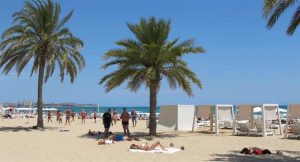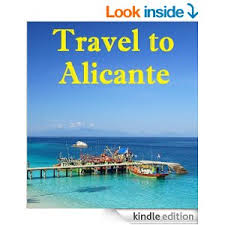Alicante is a beautiful small beach city with grand historic buildings, traditional Spanish squares, chic marina and a long sandy beach.
It’s just 12kms from Alicante airport, which is used by many budget airlines, so you can enjoy a bargain weekend in the city.
Easy city to walk around
The city centre is compact so you can easily stroll from the beach to the main attractions within a few minutes. Spain-Holiday has chosen a route where you can enjoy the sights as you stroll around this charming Mediterranean port.
Alicante marina
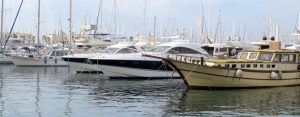
The museum is packed with information and hands-on experience of the longest and most challenging round-the-world yacht race. The race starts in Alicante in October for the third time.
Beach life
As you walk towards the centre of Alicante, you will see the long sandy Postiguet beach to your right. Cafes and restaurants line the beach so it is a favourite spot for a coffee or lunch as well as topping up your tan or having a swim.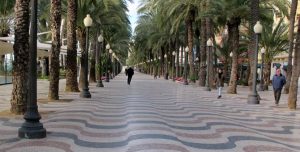
Paseo Explanada de Espana, Alicante
We’re going to turn left to walk along the iconic Paseo Explanada de Espana, which is one of the most beautiful seaside promenades in Spain.
Thousands of small red, black and cream marble tiles have been used to create the boulevard so that it resembles the waves in the sea.
Elegant Explanada de Espana
Many cafes and restaurants can be found along the Explanada, so it is a great time to visit at any time of day. Evening is popular with many people as you can have a stroll along the elegant street lined with palm trees while deciding which restaurant to dine in.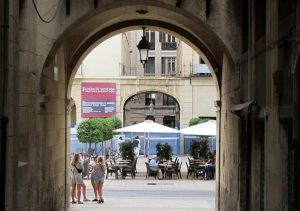
Calle Mayor, Alicante
Off the promenade on the right is the Calle San Telmo leading to the delightful Calle Mayor. Here you will find the Museum of Contemporary Art (MACA) in the Plaza Santa Maria.
The museum houses a great collection of 20th century art including works by Picasso, Miro, Dali, Max Ernst, Cocteau and Bacon.
In this square you can also visit Alicante’s oldest active church, the Basilica of Santa Maria. It’s a beautiful Gothic church built in the 14th to 16th centuries on the site of a former mosque.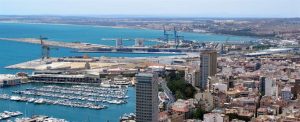
Alicante old town, marina and port
Head down Calle Niagara and you will come to another great Alicante landmark, the Museum of Fine Arts (MUBAG), housed in a former palace dating from the 18th century in Calle Gravina.
Take a trip to the town hall
Along Calle Mayor is also the elegant 18th century Alicante town hall in the Plaza de l‘Ajuntament. It is a striking Baroque building with interesting columns on the two towers.
Look out for the Salon Azul styled from the time of Queen Isabel of Spain and the Cota Cero on the main staircase which is the reference point from which Spain’s cities are measured in metres above sea level.
Heading back on to the Explanada we keep walking alongside the marina with its gorgeous sleek yachts.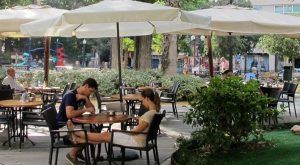
Typical Alicante plaza or square
Turn right up Avenida Dr Gadea to the Plaza Calvo Sotelo, a pretty square full of trees where you can relax or enjoy a coffee for a while.
Quality streetCalle San Francisco, Alicante, with childlike giant mushrooms
Around the square are many interesting shops including a fabulous sweet shop, Tienda Fini, with the brightest-coloured sweets you have ever seen including jelly babies, jelly beans, chocolates and mini tennis balls.
On the corner of this shop is the fascinating Calle San Francisco. A few years ago, this was pretty run down but it’s now a surreal pedestrianised street with giant mushrooms, ants and snails dotted around.
The road is a great place for dining out as various restaurants and bars have set up here including traditional cafes, a cupcake café, tapas bars, Italian restaurants and a sushi bar.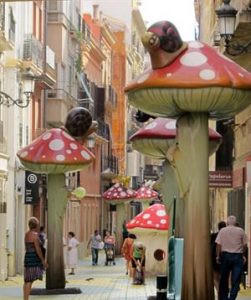
This leads you to what is arguably Alicante’s finest and best-known square, the Plaza Portal de Elche, built in the 19th century as a water supply and meeting point.
Old-fashioned air
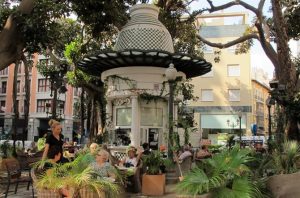
There’s a lovely old-fashioned kiosk in the square where you can read the newspapers and order a coffee. There are some beautiful old, protected trees with gnarled trunks twisted into interesting shapes.
Plaza de Portal Elche, Alicante
The square leads you to the Rambla Mendez Nunez, a famous street for restaurants and shopping.
Fine example of Spanish Baroque
San Nicolas cathedral, alicante
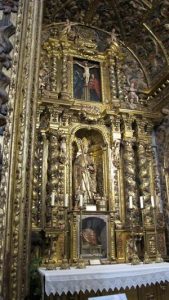 Heading up the Rambla, away from the sea, you can turn left into Calle Teatro to visit Alicante’s splendid principal theatre, in Plaza Ruperto Chapi, which stages world-famous plays and operas or turn right into Calle Miguel Soler for San Nicolas cathedral.
Heading up the Rambla, away from the sea, you can turn left into Calle Teatro to visit Alicante’s splendid principal theatre, in Plaza Ruperto Chapi, which stages world-famous plays and operas or turn right into Calle Miguel Soler for San Nicolas cathedral.
San Nicolas cathedral, in Plaza de Abad Penalva, was built over an ancient mosque in the 17th century. Worth seeing are the Holy Communion chapel which is considered to be one of the finest examples of Spanish Baroque and the distinctive blue dome, which is 45 metres high.
If you go back along the Rambla up to the busy Avenida Jaime II, you can visit the central market with stalls brimming with fresh fruit, vegetables, fish of all shapes and sizes, meat and home-made sausages.
Outside the main entrance are two traditional kiosks selling local turron, similar to nougat, while there is a colourful flower stall on the other side of the market with an amazing choice of flowers and trees.
This fascinating building looks far too grand to house a traditional market with its rectangular floor plan styled like a basilica and Modernist features.
From here you can see the imposing Alicante castle which looms over the town from a lofty height of 166 metres. It is one of Spain’s most impressive medieval fortresses with grim dungeons, lofty towers and ruins to explore.
Flower stall outside Alicante market
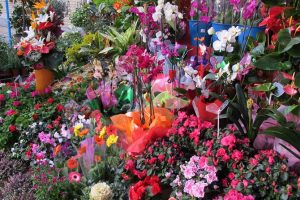 There are also tales of ill-fated lovers, battles and hundreds of years of local history to find out about.
There are also tales of ill-fated lovers, battles and hundreds of years of local history to find out about.
From the Santa Barbara Castle, there are fabulous views across the bay, marina and Alicante old town.
At the foot of the castle is La Ereta Park where you can also enjoy fabulous views of the cathedral and the port.
Cross the road and you are back to the Postiguet beach for a bite to eat or a well-earned rest.
Postiguet beach, alicante.
